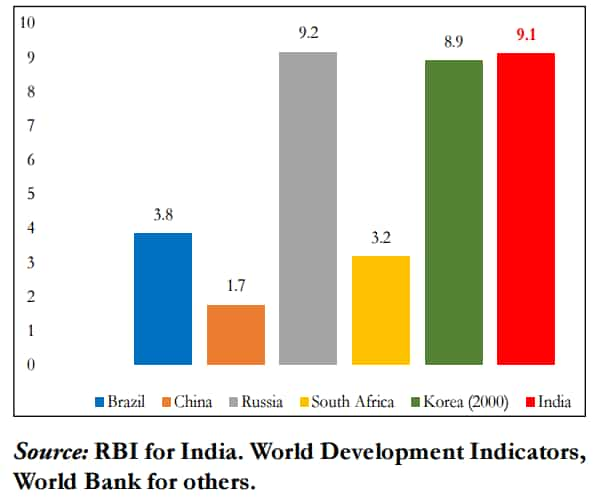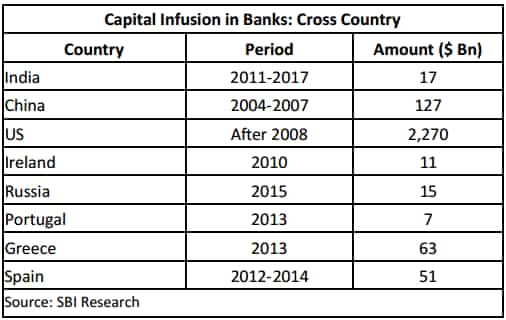NPAs: This is how other countries deal with their bad loans
As both government and RBI trying to do all they can, lets have a look at other countries who tackled with the same so-called NPA problems. Some of these methods may help India in their problem as well.

The Government of India, along with Reserve Bank of India (RBI), has working to solve the non-performing assets (NPA) crisis of the banking sector.
India's NPA ratio is at 9.1%, slightly behind Russia which is at 9.2%. This was followed by Korea (2000) which had NPA ratio of 8.9%. Other countries like Brazil, South Africa and China had 3.8%, 3.2% and 1.7% NPA ratio.

Sanjeev Prasad, Sunita Baldawa and Anindya Bhowmik, analyst at Kotak bank's research arm said "We suggest a combination of ‘curative’ and ‘preventive’ measures to address the extant NPL problem and avoid repeat failures."
They suggested two key areas, first, approval of specific resolution plans for 20-30 large stressed assets by a government committee, second, conversion of a portion of debt of stressed assets to equity may partly alleviate the problem.
"To thwart future NPLs, the government can look at ‘preventive’ measures such as (1) development of a corporate bond market and (2) empowerment of public banks’ management and private banks’ boards," they said.
Gross NPAs of gross advances which stood at Rs 1.3 lakh crore as on March 2012, have increased by a whopping 438.46% to Rs 7 lakh crore as on December 2016. As per the Economic Survey, gross NPAs climbed to almost 12% of gross advances for public sector banks at end-September 2016.
RBI now has more power to intervene in the NPA resolution and the central bank has issued directions regarding assets under corrective action plan (CAP) on joint lenders forum (JLF).
Moody's Investors Services in its recent report said. “Resolution for NPAs is a long process due to two factors - the operating environment in key stressed sectors remains quite challenging and the market value of stressed assets is typically much lower than what the banks currently reflect on their balance sheets.”
As both government and RBI trying to do all they can, lets have a look at other countries who tackled with the same so-called NPA problems. Some of these methods may help India in their problem as well.
China:
The country being in the list of twin balance sheet has significantly followed four key methods to resolve the issue.
Firstly, reducing risk by strengthening banks, raising disclosure standards and spearheading reforms of the state-owned enterprises (SOEs) by reducing their level of debt. Secondly, many laws were passed allowing creation of asset management companies, foreign equity participation in securitization and asset backed securitisation.
Moving on, government which bore the financial loss of debt were discounted and debt equity swaps were allowed in case growth opportunity existed.
To further strengthen resolution of NPA agenda, the Chinese government also implemented incentives like tax breaks, exemption from administration fees and clearcut asset evaluation norms.
Korea:
Just like China, Korea too followed the idea of securitization, debt equity swaps and asset-backed securitization method.
Apart from, the Korea government created Korea Asset Management Corp (KAMCO) and a NPA fund to fund and finance the purchase of NPAs.
Main objective of central bank of Korea was solely defined as maintaining price stability, which is why they created the Financial Supervisory Commission (FSC) to ensure an effective supervisory system in line with the universal banking practices.
Japan:
Japan government made amendment in the foreign exchange control law and the threat of suspension of banking business in case of failure to satisfy the capital adequacy ratio was prescribed.
On the corporate front, major business group established a private standard settle vehicle for Japanese accounting standards (2001) in line with the international standards.
Other countries:
Spain and Ireland both developed large state-backed asset management companies underwhich they bought stressed assets at low valuations from banks and later executed these assets to those specializing in stressed asset investing and recovery.
Ireland had further set up a National Asset Management Agency (NAMA) in 2009 for a period of 10 years. So far, NAMA had taken over almost 74 billion euro in bad loans from Irish banks in the aftermath of the crisis.
Italy also had followed the securitization move just like China and Korea.
It would be wrong to say that India has not done much for NPA resolution compared to the other countries. In fact, powerful norms have been introduced but they lack in legal hindrance, time consuming nature of asset disposal process, postponement of the problem in order to repot higher earnings, manipulation by debtors using political issues.
One of the major key hurdle that RBI faces under NPAs resolution are losses that the banks are willing to take on the value of their bad loans.
Recently, Finance Minister Arun Jaitely said the government is open in providing more funds for bank recapitalisation paring its stake once their health improves.
So far, recapitalization has been low compared to other countries. China had injected $127 billion into the banking system during 2004-07, while the US Fed injected $2.27 trillion following the 2008 crisis. In contrast, India injected $17 billion only.

Many analysts have been suggesting secularization move for India to be a good thing.
03:52 PM IST






 Falling NPAs can give a 60-bps booster shot to GDP this fiscal
Falling NPAs can give a 60-bps booster shot to GDP this fiscal Believe it or not: This bank has no NPA for 10 years; Check out what it offers
Believe it or not: This bank has no NPA for 10 years; Check out what it offers NPA's are going down; SBI’s Credit Review Department clearance needed before the loan is sanctioned: PK Gupta
NPA's are going down; SBI’s Credit Review Department clearance needed before the loan is sanctioned: PK Gupta  Banking loan crisis: NPAs to peak mid-way in FY19, muted credit pick-up, says Crisil
Banking loan crisis: NPAs to peak mid-way in FY19, muted credit pick-up, says Crisil  58% banks report rise in bad loans in July-Dec: Survey
58% banks report rise in bad loans in July-Dec: Survey